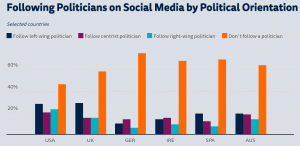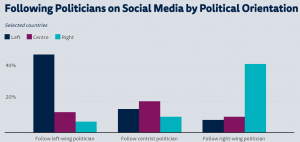Creative Commons
By Dr. Antonis Kalogeropoulos
Postdoctoral Research Fellow
Department of Politics & International Relations
Reuters Institute for the Study of Journalism
University of Oxford
In recent years, social media have enabled some politicians and political parties to communicate directly with voters, often bypassing news organisations that have traditionally mediated their ideas. Donald Trump and Barack Obama are the most prominent examples, but others like Australian Prime Minister Malcolm Turnbull have also built up a substantial following. But how extensive is this activity and what are some of the motivations for following politicians directly in this way? Across six countries, the US, UK, Ireland, Australia, Germany, and Spain, we find that almost four in ten (37%) of social media users follow a politician or political party, while 63% do not.
Q12Gi_2017. When using social media for news (e.g. Facebook, Twitter, or YouTube) have you followed or subscribed to a channel/page of a politician or political party? Please select all that apply. Base: All who used social media for news in the last week: USA, UK, Germany, Spain, Ireland and Australia = 7171. / Source: Reuters Institute Digital News Report 2017
As a percentage of the entire online population of these countries (as opposed to just social media users) around a third of Americans (35%), a quarter of Spanish (25%), a fifth of Irish (23%), Australians (20%), and British (18%), and a tenth of Germans (11%) follow a politician or party directly. While these numbers are much bigger than those traditionally associated with political parties, it is not clear how deep this engagement goes.
Based on previous research we should expect that most of those who follow in social media would follow only a few politicians with a significant reach.1 As a point of reference for the US, at the time of writing, Barack Obama has 54m followers on Facebook and 86m followers on Twitter, while Donald Trump has 21m followers on Facebook and 27m followers on Twitter. However, we expect that a substantial portion of these followers are not American and the reasons may have as much to do with celebrity (or notoriety) as politics. In the UK, both the Conservative and the Labour party are followed by approximately half a million people on Facebook, while Labour leader Jeremy Corbyn has approximately 800k followers on both Twitter and on Facebook while Theresa May has 280k followers on Twitter. In Spain, when looking at political organisations we find that the left-wing party Podemos has 1.1m followers on Facebook, orders of magnitude more than the centre-left party PSOE (142k) and the centre-right PP (172k).
In Germany, we can see that more people follow centrist politicians than left or right ones. Angela Merkel has 2.4m followers on Facebook, far ahead of the SPD candidate for the Chancellorship Martin Schultz with 380k followers. However, the two big centrist parties in Germany, the Christian Democrats (130k followers on Facebook) and SPD (136k Facebook followers) trail the populist right-wing party AfD (318k followers) and far-left Die-Linke (180k followers).
Q12Gi_2017. When using social media for news (e.g. Facebook, Twitter, or YouTube) have you followed or subscribed to a channel/page of a politician or political party? Please select all that apply. Base: All who used social media for news in the last week: USA = 1461, UK = 873, Germany = 900, Ireland = 1282, Spain = 1527, Australia = 1128. / Source: Reuters Institute Digital News Report 2017
We further find that people who follow politicians or political parties on social media are more likely to be male, under 35, and at the either end of the political spectrum rather than in the centre ground. Strikingly, very few of these politically committed followers show any interest in following politicians from the other side of the political spectrum. Only 7% of right-wing identifiers on social media follow a left-wing politician on social media, while only 8% of left-wing identifiers on social media follow a right-wing politician on social media. Just 4% of social media news users follow both left- and right-wing politicians on social media. It seems that political following on social media tends to be a public statement of allegiance from those who are already politically committed rather than a genuine attempt to have a dialogue. The high levels of following in the United States and low levels in Germany reflect the different numbers of people who hold polarised views in those countries.
Q1F. Some people talk about ‘left’, ‘right’, and ‘centre’ to describe parties and politicians. With this in mind, where would you place yourself on the following scale? Q12Gi_2017. When using social media for news (e.g. Facebook, Twitter, or YouTube) have you followed or subscribed to a channel/page of a politician or political party? Base: All who used social media for news in the last week: USA, UK, Germany, Spain, Ireland and Australia = 7171. / Source: Reuters Institute Digital News Report 2017
Why Follow Politicians on Social Media?
When asked why they follow politicians on social media, the two most commonly cited answers were ‘I prefer to hear directly of a politician/political party than have their views filtered by others’ (48%) and ‘I like a particular politician/political party’ (46%). Overall, 68% of respondents picked an answer that revealed some form of distrust towards the media to inform them about politicians.
Q12Gii_2017. You say you follow a politician or political party via social media, what are some of the reasons for this? Base: All who follow a politician or political party on social media: USA, UK, Germany, Spain, Ireland, and Australia = 2671. / Source: Reuters Institute Digital News Report 2017
When looking at how some of these reasons vary according to political orientation in two countries (the US and Spain), we see different dynamics. In the US, right-wing identifiers are much more likely to follow politicians on social media because of media distrust. Left-wing identifiers are more likely to follow politicians on social media to show to others who they support politically. In Spain, left-wing voters are more likely than centrist voters to follow politicians because of media distrust.
Q1F. Some people talk about ‘left’, ‘right’, and ‘centre’ to describe parties and politicians. With this in mind, where would you place yourself on the following scale? Q12Gii_2017. You say you follow a politician or political party via social media, what are some of the reasons for this? Base: All on the left/centre/right who follow a politician or political party on social media: USA = 293/268/199, Spain = 205/223/31. / Source: Reuters Institute Digital News Report 2017
Q1F. Some people talk about ‘left’, ‘right’, and ‘centre’ to describe parties and politicians. With this in mind, where would you place yourself on the following scale? Q12Gii_2017. You say you follow a politician or political party via social media, what are some of the reasons for this? Base: All on the left/centre/right who follow a politician or political party on social media: USA = 293/268/199, Spain = 205/223/31. / Source: Reuters Institute Digital News Report 2017
Overall, we find that direct online communication between politicians and individuals remains a minority activity. However, given that distrust towards the media is a strong reason for following politicians it may be something that grows in the coming years.
Footnote
- Rasmus Kleis Nielsen and C. Vaccari, Do People ‘Like’ Politicians on Facebook? Not Really. Large-Scale Direct Candidate-to-Voter Online Communication as an Outlier Phenomenon. International Journal of Communication 7 (2013): 24.
Originally published by Reuters Digital News Report under a Creative Commons Attribution 3.0 Unported license.








